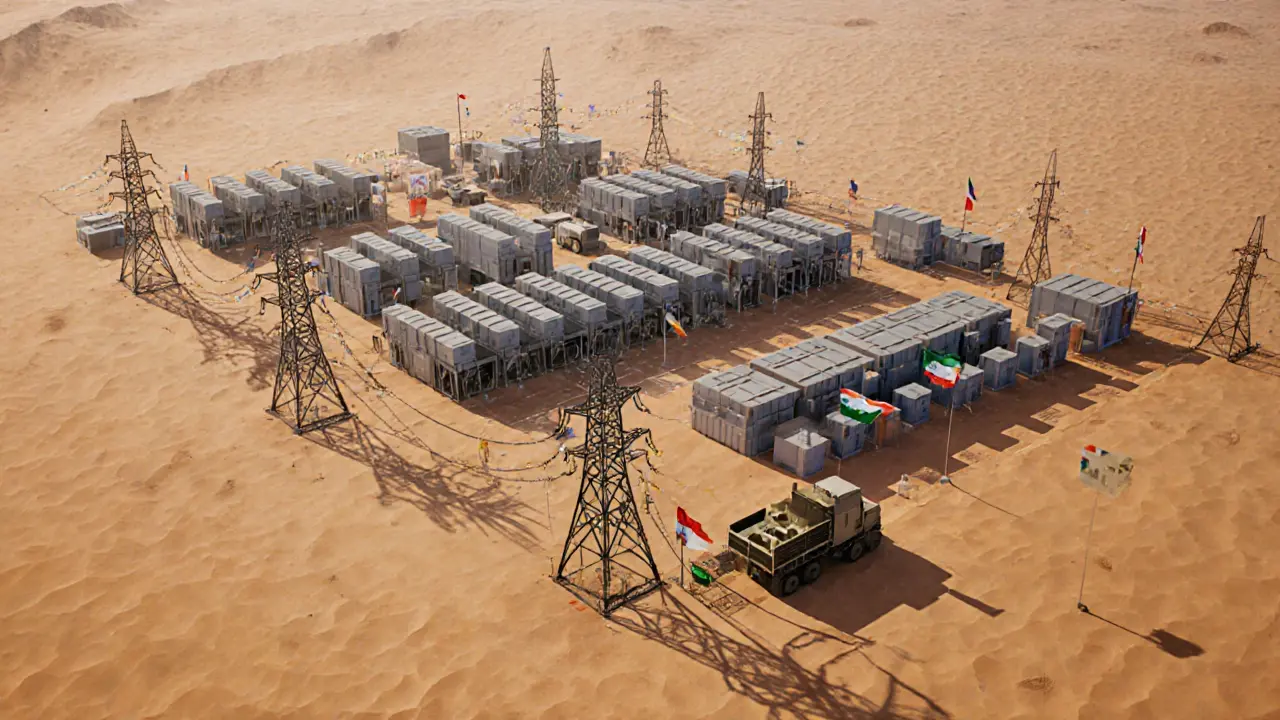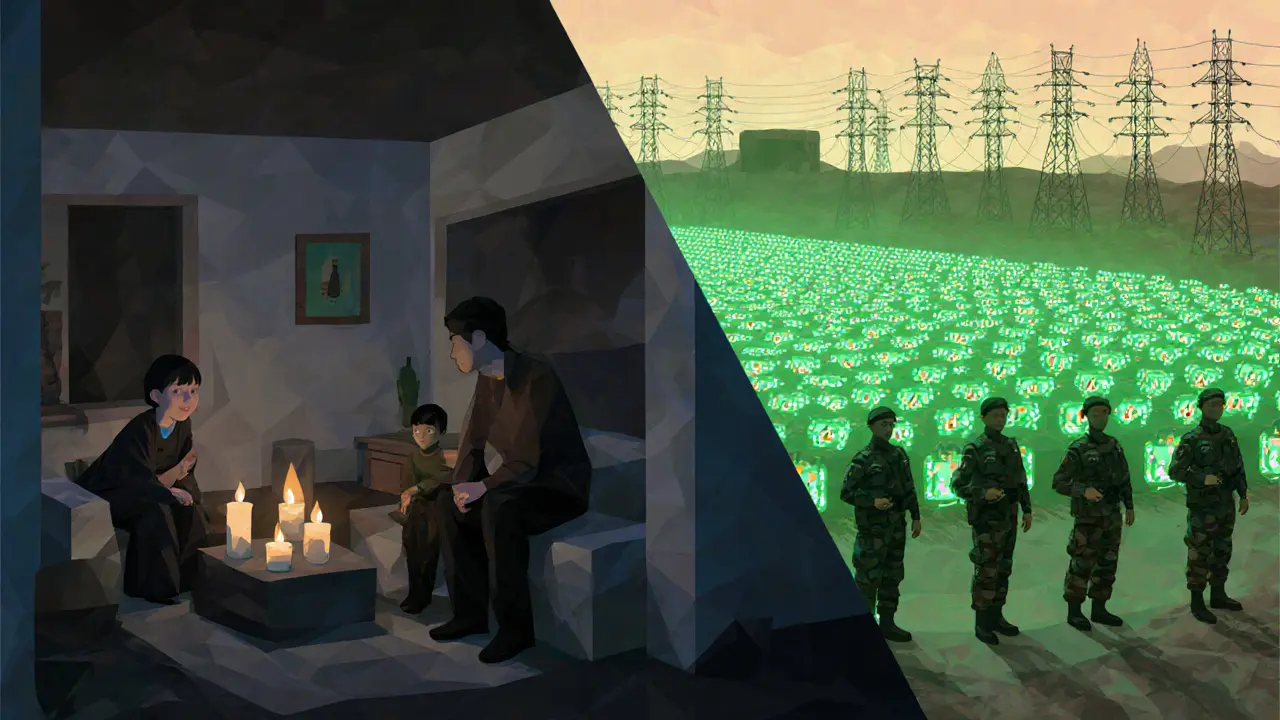IRGC‑Backed Unlicensed Crypto Mining in Iran: How the Guard Corps Fuels Sanctions Evasion
 Oct, 15 2025
Oct, 15 2025
IRGC Crypto Mining Cost Calculator
Calculate Your Mining Costs
See how much the IRGC saves on electricity compared to licensed miners using real-world data from Iran's mining industry.
Cost Comparison Results
Licensed Miners
Electricity Cost: $0.00
Daily Cost: $0.00
IRGC Operations
Electricity Cost: $0.00
Daily Cost: $0.00
When you hear that Iran is one of the world’s biggest Bitcoin producers, the first question is often: who’s really behind the rigs humming in the dark? The answer points straight at the Islamic Revolutionary Guard Corps (IRGC is a powerful Iranian military‑economic organization that answers directly to the Supreme Leader and runs a sprawling network of businesses, from missiles to mineral extraction). In recent years the IRGC has turned that muscle toward crypto mining - not as a public‑service industry, but as a covert profit centre that sidesteps sanctions, hogs cheap electricity, and leaves ordinary Iranians in the dark.
Why Unlicensed Mining Matters
Iran officially legalized crypto mining in 2019, but the license regime is a trap for independent operators. Licensed miners pay high tariffs, must sell their coins to the Central Bank of Iran (Central Bank of Iran is the country’s monetary authority that controls the rial, foreign‑exchange flow and, since 2024, the few legal pathways for crypto‑fiat conversion), and face strict reporting. The IRGC exploits the loophole by running massive IRGC cryptocurrency mining farms that technically sit outside the licensing system, letting them buy electricity at near‑zero cost and keep every Bitcoin they generate.
How the Guard Corps Built a Crypto Cartel
By 2019‑2020 the IRGC began partnering with Chinese hardware firms to set up industrial‑scale ASIC farms. The flagship project is the Rafsanjan mining complex in Kerman Province (Rafsanjan mining farm is a 175‑megawatt Bitcoin operation built as a joint venture between an IRGC‑linked enterprise and foreign investors, located in a special economic zone with a dedicated power line). The location choice is deliberate: remote, military‑controlled sites can tap directly into subsidised electricity without paying the national grid.
Estimates suggest around 180,000 mining rigs are active in Iran, with roughly 100,000 under IRGC or affiliated hands. That means more than half of the country’s hash power is effectively state‑run, turning Iranian electricity-already strained by sanctions‑driven shortages-into a cash‑generating machine for the Guard.
Electricity: The Real Currency
What makes the IRGC’s operation so profitable isn’t the price of Bitcoin; it’s the price of power. In 2022 Parliament quietly passed a law that let the military create its own power plants and transmission lines. The result? The IRGC can draw electricity for free, or simply ignore utility bills, while ordinary households face rolling blackouts lasting hours or even days. Energy Minister Ali Abadi (Ali Abadi is a former IRGC commander who now heads Iran’s energy ministry and has publicly called illegal crypto mining ‘an ugly theft’) has admitted that the practice is akin to “putting a hand in others’ pockets,” but his previous ties raise doubts about any real crackdown.

Sanctions Evasion 101
Crypto’s appeal to Iran isn’t just profit-it offers a way around U.S. and EU sanctions. Bitcoin transactions can move across borders without banks, making it easier for the IRGC to fund proxy groups or purchase hard‑to‑get parts for missiles. U.S. Treasury and Israeli intelligence have repeatedly flagged wallets linked to IRGC entities, showing how mined coins get funneled into regional covert operations.
Licensed vs. Unlicensed Mining: A Quick Comparison
| Aspect | Licensed (Ministry of Industry) | Unlicensed (IRGC‑affiliated) |
|---|---|---|
| Electricity Cost | Full market tariff (≈ $0.05/kWh) | Subsidised or free (≈ $0‑$0.01/kWh) |
| Legal Oversight | Required permits, regular audits | No permits, armed protection |
| Profit Flow | Must sell to Central Bank, low margins | Direct market sales, high margins |
| Risk of Shutdown | High - could lose license | Low - shielded by military |
| Impact on Grid | Limited, regulated consumption | Massive, causes blackouts |
Key Players Around the Guard
Beyond the IRGC itself, several institutions act as financial conduits:
- Astan Quds Razavi is a massive charitable trust (bonyad) overseen by the Supreme Leader that channels billions of rials into IRGC‑linked mining projects.
- Supreme Leader Ali Khamenei issues the strategic directives that legitimize the Guard’s crypto push, framing it as a “national resistance” against sanctions.
- Foreign hardware suppliers-mostly Chinese ASIC manufacturers-provide the cutting‑edge equipment that makes Iran’s hash rate competitive on the global stage.

What This Means for Ordinary Iranians
The human cost is stark. When the IRGC redirects power to its farms, families lose lights, schools close early, and factories halt production. The country's already‑fragile economy suffers as industrial output drops, further weakening the rial.
Meanwhile, citizens who want to use crypto for everyday purchases face a maze of restrictions. The Central Bank’s 2024 decree blocked direct crypto‑to‑rial payments on domestic websites. By early 2025, a selective API allowed vetted exchanges to operate, but only after users submit detailed personal data-essentially turning the system into a state‑run surveillance platform.
International Response and Future Outlook
Western governments have started targeting the wallets tied to IRGC mining. Sanctions now list specific Bitcoin addresses, and financial institutions are warned to freeze any transfers linked to those hashes. However, the Guard’s ability to move coins through mixers and offshore exchanges makes enforcement a cat‑and‑mouse game.
Looking ahead, two scenarios dominate:
- Escalation: Iran doubles down, expanding mining capacity in undisclosed military zones, further draining the grid and prompting more severe internal unrest.
- Regulation Crackdown: Domestic pressure forces the government to re‑assign the free‑electricity lines, but the IRGC’s entrenched economic interests make a full shutdown unlikely.
Either way, the nexus of sanctions, cheap power, and military backing ensures that crypto mining will stay a core revenue stream for the IRGC for the foreseeable future.
Bottom‑Line Checklist
- IRGC controls roughly half of Iran’s mining hardware.
- Free or heavily subsidised electricity fuels massive profit margins.
- Sanctions‑evasion is a primary motive - mined coins fund overseas operations.
- Ordinary citizens bear the brunt through blackouts and restricted crypto access.
- International sanctions now target specific wallets, but enforcement remains tricky.
Frequently Asked Questions
Is crypto mining legal in Iran?
Officially, yes-mining is legal if you obtain a license from the Ministry of Industry, Mines and Trade. In practice, licensed miners face high electricity tariffs and must sell their coins to the Central Bank, making it financially unviable for most. Unlicensed, IRGC‑linked farms operate in a legal gray area, exploiting loopholes and military protection.
How does the IRGC obtain cheap electricity?
Parliament passed a 2022 law allowing the military to build its own power plants and transmission lines. The IRGC then taps these private grids or simply refuses to pay the national utility, effectively getting electricity for free.
What impact does IRGC mining have on everyday Iranians?
Massive power draws cause rolling blackouts, hampering homes, schools, and factories. The reduced industrial output further weakens the economy, while ordinary citizens also face tighter crypto regulations and limited access to global markets.
Can international sanctions stop IRGC crypto operations?
Sanctions now list specific Bitcoin addresses tied to the IRGC, making it easier for banks to block related transactions. However, the Guard uses mixers, offshore wallets, and peer‑to‑peer transfers that are hard to trace, so enforcement is only partially effective.
What are the chances the IRGC will shut down its mining farms?
Low. Mining provides a vital source of hard currency that helps bypass sanctions. Even if domestic pressure rises, the Guard’s military backing and control over subsidised power make a full closure unlikely without a major political shift.


Steve Cabe
October 15, 2025 AT 09:30The IRGC's crypto mining enterprise is a blatant violation of international sanctions, and it underscores the regime's willingness to weaponize digital assets. By siphoning cheap electricity, they undercut legitimate miners and profit from the very restrictions meant to isolate Iran. This operation is a strategic move to generate untraceable revenue for the Guard.
shirley morales
October 21, 2025 AT 18:17One can only lament the moral decay that permits a paramilitary organization to exploit digital currencies for illicit profit.
Mandy Hawks
October 28, 2025 AT 03:03In contemplating the IRGC's unlicensed mining, one observes a paradox where a state actor embraces the decentralization ethos while simultaneously flouting international law. The calculus is not merely financial; it reflects an ideology of self‑sufficiency that borders on defiance. Electricity, the lifeblood of mining, becomes a tool of political leverage. The sanctions‑evasion narrative thus intertwines with domestic power dynamics. Ultimately, the venture reveals how technology can be repurposed as an instrument of statecraft.
Scott G
November 3, 2025 AT 11:50It is disconcerting to note how the Iranian Guard Corps has appropriated an energy‑intensive activity, thereby exacerbating the already fragile grid. The humanitarian implications of persistent blackouts cannot be ignored, especially for vulnerable populations. While the financial incentives are evident, the broader societal cost must be weighed. I trust that policymakers will consider both economic and ethical dimensions in addressing this challenge.
VEL MURUGAN
November 9, 2025 AT 20:37The cost‑benefit analysis shows that the IRGC saves millions on electricity, which directly fuels their mining profits.
Russel Sayson
November 16, 2025 AT 05:23Let me break down exactly why the IRGC's crypto mining operation is a masterclass in sanctions evasion. First, the Guard has unfettered access to Iran’s subsidized power grid, allowing them to run rigs at near‑zero cost. Second, the lack of licensing means there is no regulatory oversight, so the electricity consumption is hidden from any external audit. Third, the profits generated are funneled through a maze of shell companies, making it nearly impossible for foreign authorities to trace the cash flow. Fourth, the hardware is often sourced via gray‑market channels that mask the true origin, further complicating enforcement. Fifth, the mining farms are strategically located in remote provinces, where grid monitoring is minimal. Sixth, the IRGC leverages its political clout to obtain favorable tariffs, effectively subsidizing their operation at the taxpayer’s expense. Seventh, the sheer volume of rigs-estimated in the hundreds of thousands-creates a substantial hash rate that can influence market dynamics. Eighth, the generated cryptocurrency can be swapped for fiat through a network of compliant exchanges that are unaware of the underlying illicit electricity usage. Ninth, the proceeds are then reinvested into the Guard’s military procurement, closing the loop between illicit finance and state power. Tenth, this entire ecosystem operates under the radar of international sanctions bodies because the crypto aspect is relatively new and poorly understood. Eleventh, any attempt to interdict the operation would require cooperation from multiple jurisdictions, each with its own legal complexities. Twelfth, the environmental toll-frequent blackouts and increased carbon emissions-adds a layer of domestic dissent that the regime can suppress. Thirteenth, the IRGC’s control over the mining infrastructure gives them leverage over other domestic crypto actors, consolidating their dominance. Fourteenth, the profits enable the development of cyber capabilities that can be weaponized against adversaries. Fifteenth, this model sets a dangerous precedent for other sanctioned regimes seeking similar revenue streams. Sixteenth, in sum, this operation is not just about money; it is a strategic instrument of geopolitical resilience against Western pressure.